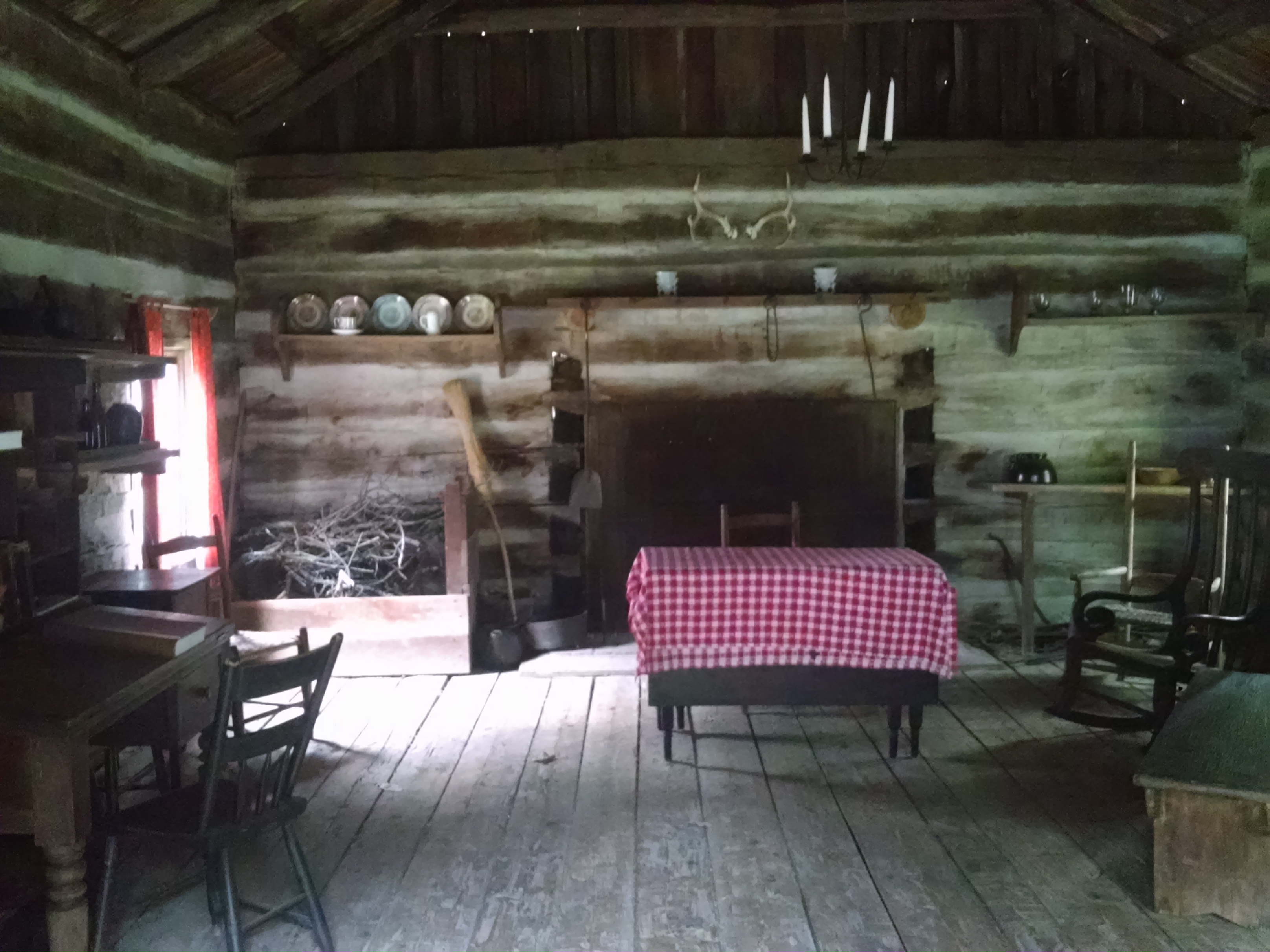Howard

Picture of inside of reconstructed log home in New Salem, Illinois where young Abe Lincoln lived. This log home is probably similar to homes that the Howards lived in when they moved to Illinois.
In the southeastern part of Madison County, Illinois the first traces of settlement appear in 1809. Mrs. Lydia Stewart Howard, a widow with several grown sons (Abraham and Joseph) and daughters had emigrated from Tennessee and made their home on a beautiful ridge covered with timber on the edge of the Looking Glass prairie. History of Madison Co., Illinois, page 80
In its natural state the Looking Glass Prairie was a most beautiful tract of country. A former writer said: "It looked more like a great park than a wild country. This was not like many other prairies, a monotonous level, where the eye can find no resting-place. Out of this plain covered with luxuriant grass and flowers of all colors rose a great number of beautiful and shapely hills, all easy to ascend, and many covered with a growth of fine trees. Small watercourses frequently embellished with fine willows crossed the prairie in all directions. A number of small groves ornamented the scenery made up of trees of great variety such as linden, oak, hickory, buckeye and locust. The timber-crowned hills of Silver Creek and the rich forests of Sugar Creek surrounded the landscape in all directions. Along the skirt of timber you might see at different points not far apart a small field pushed out into the prairie. The cabins were mostly hidden by the trees and only the smoke arising from them disclosed the abode of man." History of Madison Co., Illinois, pages 463-464.
The Looking Glass Prairie for a distance of many miles was spread out before their view. The Howard's land was about one mile northwest of the present town of Highland, Illinois.Ten miles to the south, a short distance north of the present town of Lebanon, a few white men had erected their cabins. Likewise to the east, on Shoal Creek, some settlements had been made. To the east were the improvements on Ridge Prairie, near the present towns of Troy and Edwardsville. On the north not a single white man had erected his pioneer habitation. There were only eleven families in all of this part of the county to seek the protection of Chilton�s Fort during the troubles with the Indians in the war of 1812-14. Histories of Madison Co., Illinois, page 80
At Chilton's Fort, St. Jacobs Township, the families lived in peace and quiet until the war with England broke out in 1812, and the Indians began to show their hostility. Augustus Chilton and his neighbors who lived in this and adjoining townships, built a fort and stockade for defense.The fort stood in the northwest corner of section 17 near where Augustus Chilton settled. Major Isaac Ferguson and Capt. Abraham Howard commanded the fort. The Indians never attacked this fort. We received a description of this fort from Jesse J. Renfro, a worthy old citizen of Madison County and a Ranger during the war of 1812. During the winter of 1814, he with a dozen other rangers was placed on guard here under the command of Samuel Whiteside. At this time the pioneers lived at their homes in the settlement and would only come into the fort upon hearing of some Indians depredations.
When the Saline Township was first settled it was about equally divided between timber and prairie lands. Silver and Sugar Creeks drained it. Silver Creek flows in a southerly direction through the western part. Sugar Creek drains the eastern and more central portion. It was here in 1809 on the edge of the Silver Creek timber, on the eastside of section thirty-one, the first cabin was erected in the southeast part of Madison County. Widow Lydia Stewart Howard and several grown children inhabited the first cabin that stood on the northwest quarter of the northeast quarter of the section.
It was related by an old settler and a relative of the Howards of an event that happened on 16 Nov. 1811. A great earthquake of that year caused much terror among the pioneers. The Howard�s felt the shock so erceptibly that they thought the Indians were on the cabin roof with murderous intentions. With the bravery characteristic of the Howards, Abraham and Joseph took up their rifles and opened the cabin door cautiously. After peering around and seeing no Indians though the shaking still continued, they came to the conclusion that the Indians were surely on the house top, where they had no business being. That they must be dislodged immediately for the safety of the family flashed through the midst of the Howard�s. So they walked backward cautiously out of the cabin with uplifted rifles ready to shoot the first copper-colored peace-disturber that became visible. One of them went to the right and the other to the left until they came in sight of each other in the rear of the cabin. To their surprise no Indians were to be seen. They looked about them, and all was still as death. They re-entered the cabin believing some lonely hunter that had been passing by had made them the victims of a practical joke. History of Madison Co. Illinois, page 544.
In the Saline.Township, as early as 1825, the Cumberland Presbyterians improved a camp ground on section 31. On this ground in a cabin belonging to Captain Abraham Howard, was the first school taught by John Barber, Jr. He continued in the work for several terms finding great favor with pioneers. Captain Abraham Howard, in 1830, went to Fayette County, Illinois and settled a place east of Vandalia, now known as Howard�s Point. History of Madison Co., Illinois, page 271
Abraham Howard was a 3rd ggrandfather of George W Etters.